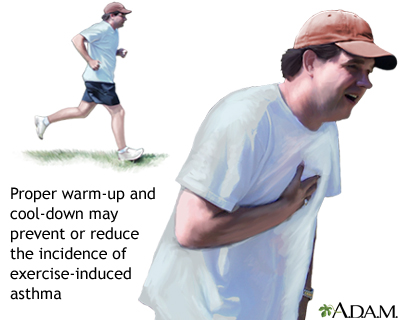Exercise-induced asthma
Wheezing - exercise-induced; Reactive airway disease - exercise; Exercise-induced bronchoconstriction

Wheezing can be a normal healthy response to an unhealthy environment. Or, wheezing can be a sign of asthma. I'm Dr. Alan Greene and I want to talk with you for a moment about how to tell the difference, what causes wheezing anyway, and when is it healthy and when is it not. Well to understand that, first let's all take a deep breath together (inhales). When you breathe in, the air comes through your nose or mouth, through the big windpipe and breaks into 2 big bronchi, one into each lung. And from there they break into a whole bunch of little, smaller bronchioles. It's almost like a tree's branches branching out. And those bronchioles are where the wheezing happens. Let's look at a bronchiole. Here's one of those small airways. Now if you happen to walk into a cloud of something that's toxic, your body is going to respond instantly to try to protect you. The first thing that will happen is the muscles around the bronchioles will tighten, will constrict down almost like a boa constrictor, and you get the tight airways. If that toxic cloud is still there, to protect your delicate tissues deep in your lungs, swelling of the lining will happen. Inflammatory stuff to help protect you from those toxins. And if it's still there, still irritating, mucus will begin to be secreted to be able again to capture and protect you from those toxins. That's wheezing. Asthma happens when your airways are hyper-responsive. When they're twitchy. When they're hyper-alert and they respond to something that's not truly dangerous. The problem with that is when your bronchioles are constricted and swollen and has mucus in them, that narrow little opening is hard to breathe through. You have to work to breathe, especially to breath out. And that hard breathing through a narrow passageway is what creates the sound we know as wheezing.

Exercise-induced asthma is distinct from allergic asthma in that it does not produce long-term increase in airway activity. People who only experience asthma when they exercise may be able to control their symptoms with preventive measures such as warm-up and cool-down exercises.
Be Careful Where and When you Exercise
Having asthma symptoms when you exercise does not mean you cannot or should not exercise. But be aware of your EIB triggers.
Cold or dry air may trigger asthma symptoms. If you do exercise in cold or dry air:
- Breathe through your nose.
- Wear a scarf or mask over your mouth.
Do not exercise when the air is polluted. Avoid exercising near fields or lawns that have just been mowed.
Warm up before you exercise, and cool down afterward:
- To warm up, walk or do your exercise activity slowly before you speed up.
- The longer you warm up, the better.
- To cool down, walk or do your exercise activity slowly for several minutes.
Some kinds of exercise may be less likely to trigger asthma symptoms than others.
- Swimming is a good sport for people with EIB. The warm, moist air helps keep asthma symptoms away.
- Football, baseball, and other sports with periods when you do not move fast are less likely to trigger your asthma symptoms.
Activities that keep you moving fast all the time are more likely to trigger asthma symptoms, such as running, basketball, or soccer.
Use Your Asthma Medicine Before you Exercise
Take your short-acting, or quick-relief, inhaled medicines before you exercise.
- Take them 10 to 15 minutes before exercise.
- They can help for up to 4 hours.
Long-acting, inhaled medicines may also help.
- Use them at least 30 minutes before exercise.
- They can help for up to 12 hours. Children can take this medicine before school, and it will help for the whole day.
- Be aware that using this kind of medicine every day before exercise may make it less effective over time.
Follow your health care provider's advice on which medicines to use and when.
References
Brannan JD, Kaminsky DA, Hallstrand TS. Approach to the patient with exercise-induced bronchoconstriction. In: Burks AW, Holgate ST, O'Hehir RE, et al, eds. Middleton's Allergy: Principles and Practice. 9th ed. Philadelphia, PA: Elsevier; 2020:chap 54.
Lugogo N, Que LG, Carr TF, Kraft M. Asthma: diagnosis and management. In: Broaddus VC, Ernst JD, King TE, et al, eds. Murray and Nadel's Textbook of Respiratory Medicine. 7th ed. Philadelphia, PA: Elsevier; 2022:chap 62.
National Heart, Lung and Blood Institute. Asthma Management Guidelines: Focused Updates 2020.
Vohra TT, Nowak RM. Asthma. In: Walls RM, ed. Rosen's Emergency Medicine: Concepts and Clinical Practice. 10th ed. Philadelphia, PA: Elsevier; 2023:chap 59.
Version Info
Last reviewed on: 2/3/2024
Reviewed by: Frank D. Brodkey, MD, FCCM, Associate Professor, Section of Pulmonary and Critical Care Medicine, University of Wisconsin School of Medicine and Public Health, Madison, WI. Also reviewed by David C. Dugdale, MD, Medical Director, Brenda Conaway, Editorial Director, and the A.D.A.M. Editorial team.
